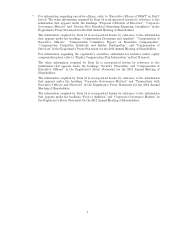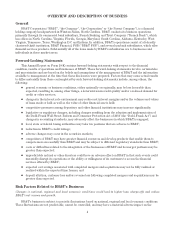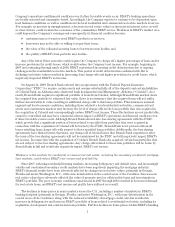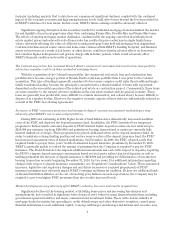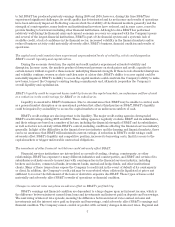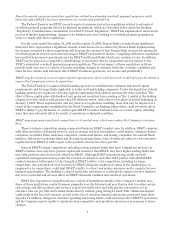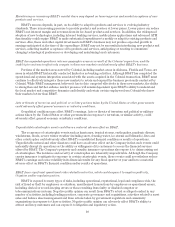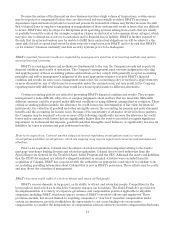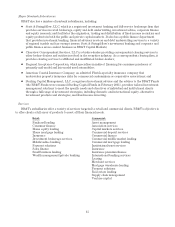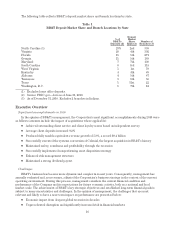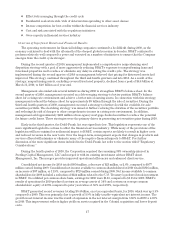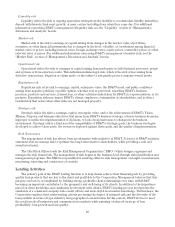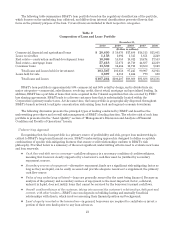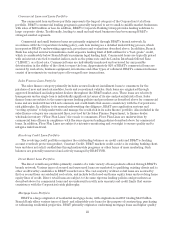BB&T 2010 Annual Report Download - page 13
Download and view the complete annual report
Please find page 13 of the 2010 BB&T annual report below. You can navigate through the pages in the report by either clicking on the pages listed below, or by using the keyword search tool below to find specific information within the annual report.costs currently not anticipated or reduced cost savings resulting from such mergers or acquisitions. Annual cost
savings in each such transaction may be materially less than anticipated if the holding company, bank merger or
nonbank merger or acquisition is delayed unexpectedly, the integration of operations is delayed beyond what is
anticipated or the conversion to a single data system is not accomplished on a timely basis.
Difficulty in integrating an acquired company may cause the Company not to realize expected revenue
increases, cost savings, increases in geographic or product presence and/or other projected benefits from the
acquisition. The integration could result in higher than expected deposit attrition, loss of key employees,
disruption of BB&T’s businesses or the businesses of the acquired company, or otherwise adversely affect the
Company’s ability to maintain relationships with customers and employees or achieve the anticipated benefits of
the acquisition. Also, the negative effect of any divestitures required by regulatory authorities in acquisitions or
business combinations may be greater than expected.
BB&T may not receive the regulatory approvals required to complete a bank merger.
BB&T must generally receive federal and/or state regulatory approvals before it can acquire a bank or bank
holding company. In determining whether to approve a proposed bank acquisition, bank regulators will consider,
among other factors, the effect of the acquisition on competition, financial condition and future prospects,
including current and projected capital ratios and levels, the competence, experience and integrity of
management and record of compliance with laws and regulations, the convenience and needs of the communities
to be served, including the acquiring institution’s record of compliance under the Community Reinvestment Act,
and the effectiveness of the acquiring institution in combating money laundering activities. In addition, BB&T
cannot be certain when or if, or on what terms and conditions, any required regulatory approvals will be granted.
In specific cases the Company may be required to sell banks or branches, or take other actions as a condition to
receiving regulatory approval.
BB&T’s stock price can be volatile.
BB&T’s stock price can fluctuate widely in response to a variety of factors including:
Šactual or anticipated variations in quarterly operating results;
Šrecommendations by securities analysts;
Šnew technology used, or services offered, by competitors;
Šsignificant acquisitions or business combinations, strategic partnerships, joint ventures or capital
commitments by or involving the Company or the Company’s competitors;
Šfailure to integrate acquisitions or realize anticipated benefits from acquisitions;
Šoperating and stock price performance of other companies that investors deem comparable to BB&T;
Šnews reports relating to trends, concerns and other issues in the financial services industry;
Šchanges in government regulations, accounting standards and tax laws; and
Šgeopolitical conditions such as acts or threats of terrorism or military conflicts.
General market fluctuations, industry factors and general economic and political conditions and events, such
as economic slowdowns or recessions, interest rate changes, credit loss trends, or currency fluctuations could also
cause BB&T’s stock price to decrease regardless of the Company’s operating results.
Operating Subsidiaries
At December 31, 2010, the principal operating subsidiaries of BB&T included the following:
ŠBranch Banking and Trust Company, Winston-Salem, North Carolina
ŠBB&T Financial, FSB, Columbus, Georgia
ŠScott & Stringfellow, LLC, Richmond, Virginia
13


